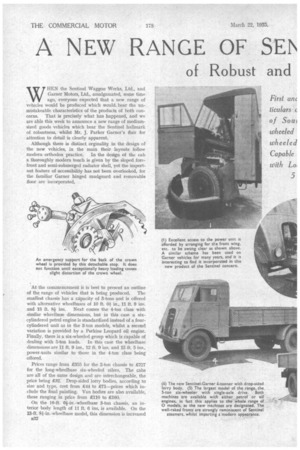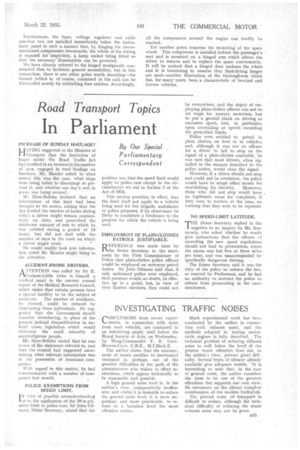A NEW RANGE OF SEN 1 INEL -GARNER CHASSIS
Page 46

Page 47

Page 48

Page 49

If you've noticed an error in this article please click here to report it so we can fix it.
of Robust and radical Design
HEN the Sentinel Waggon Works, Ltd„ and Garner Motors, Ltd., amalgamated, some time ago, everyone expected that a new range of vehicles would be produced which would bearthe unmistakeable characteristics of the products of both concerns. That is precisely what has happened, and we are able this week to announce a new range of mediumsized goods vehicles which bear the Sentinel hallmark of robustness, whilst Mr. J. Parker Garner's flair for attention to detail is clearly apparent.
Although there is distinct orginality in the design of the new vehicles, in the main their layouts follow modern orthodox practice. In the design of the cab a thoroughly modern touch is given by the sloped forefront and semi-submerged radiator shell, yet the important feature of accessibility has not been overlooked, for the familiar Garner hinged mudguard and removable floor are incorporated.
At the commencement it is best to present art outline of the, range of vehicles that is being produced. The smallest chassis has a capacity of 3-tons and is offered with alternative wheelbases of 10 ft. 04 in., 11 ft. 9 ins. and 13 It. 81 ins. Next comes the 4-ton class with similar wheelbase dimensions, but in this case a sixcylindered petrol engine is standardized instead of a fourcylindered unit as in the 3-ton models, whilst a second variation is provided by a Perkins Leopard oil engine. Finally, there is a six-wheeled group which is capable of dealing with 5-ton loads. In this case the wheelbase dimensions are 11 ft. 9 ins., 12 ft. 9 ins. and 15 ft. 5 ins., power-units similar to those in the 4-ton class being offered.
Prices range from £355 for the 3-ton chassis to £727 for the long-wheelbase six-wheeled oilers. The cabs are all of the same design and are interchangeable, the price being £32. Drop-sided lorry bodies, according to size and type, cost from £44 to An—prices which include the final painting. Van bodies are also available, these ranging in price from £110 to £160.
On the 10-ft. Ofin.-wheelbase 3-ton chassis, an interior body length of 11. ft. 6 ins, is available. On the 13-ft. 8i-in.-wheelbase model, this dimension is increased n32
to 16 ft. 9 ins., whilst in the case of the longest wheelbase six-wheeler, the interior length can be as much as 19 ft. 2 ins. In all cases a Maximum width of 6 ft. Sins. is permissible, whilst for the vans various designs are in existence which range in height from 5 ft. 6 ins. to 8 ft. 6 ins.
Among the constructional details of the new models there are many features of outstanding merit. Simplicity characterizes the design of both the four-wheeled and six-wheeled chassis, the frames in each case having straight side-members with adequate tubular crossbracing. Apart from four or, in some cases, five 2i-in. diameter tubes placed athwart the chassis, there is a further pair of lighter tubes placed diagonally at the rear, to prevent lozenging. . . .
At the front, a deep U-shaped cross-member is bolted to the frame in an ingenious manner ; the significance of the particular form of construction employed will be apparent when it is explained that the engine, clutch and gearbox can be withdrawn from the front of the chassis, an operation which, entails releasing this front cross-member. Above the centre of the member is formed a rubber-lined trunnion bearing, which surrounds a forward extension of the engine timing-case around the crankshaft.
At each side of the cross-member are cones which are received by similarly shaped members attached to the frame. A bolt, passing through the centre of each cone, forms the means for securing the cross_ member to the frame longitudinal.
The rear engine mounting is particularly interesting, for the brackets, which are attached to the flywheel housing, are normally fully insulated from the frame by rubber with spring-loaded retaining bolts. There is, however, a tapped hole on the outer extremity of each bracket which is intended to receive a bolt with a roller attached. By levering each engine arm upwards for a matter of half-an-inch, the bolt and its roller can be inserted, so that the engine rests on the rollers and is then free to run forward along the top of the frame.
A. truck placed under the front cross-member allows the complete unit to be withdrawn, until the rollers
come to the end of the frame, when they drop into adapgrs, which are screwed into the ends of the dumb-irons after the bumper bar has been removed. For owners of fleets, this system has much to recommend it, for it enables a replacement engine unit to be installed overnight, thereby keeping the vehicle on the road without interruption. Another feature of interest concerns the water system. In all chassis an auxiliary or make-up tank is installed in the front of the cab with pipes leading to the radiator. It is equipped with a level indicator and the filling orifice is incorporated at the top of the tank.
The four-cylindered petrol engine has bore and stroke dimensions of 90 mm. and 130 mm. respectively (3.308 litres) and it develops 49 b.h.p. at 2,400 r.p.m. Overhead valves contained in a detachable cylinder head, a fullpressure lubrication system 'and coil ignition are features.
Side valves are used in the six-cylindered unit, the bore being 79.5 mm. and the stroke 114.5 mm., giving a swept volume of 3.400 litres; 60 b.h.p. is developed at 3,000 r.p.m. Both the cylinder, block and the head are detachable, and the crankshaft runs in no fewer than eight bearings; an air-cleaner is fitted. to the vertical carburetter.
A single-dry-plate clutch and four-speed gearbox are incorporated with the engine, mounting faces for a mechanical tyre pump, and a power take-off being provided on the near side and the off side respectively.
The gearbox is of sturdy construction, being short and compact, with the main and layshafts running on ball nearings. The indirect ratios are 1.82, 3.26 and 5.71 to I for the forward gears, with 8.23 to 1 for reverse. The standard rear-axle ratio for the 3-tonner is 51 to 1, for the 4-tonner, 6/ to 1, and for the 5-tonner, 7 to 1.
W.xcept on the 10-ft. wheelbase chassis, a two-piece propeller shaft with three universal joints and a self-aligning centre bearing is used, a Hardy fabric coupling being provided for the stem-wheel of the gearbox, and Hardy Spicer rear and centre universal joints in the shaft.
Particular interest attaches to the design of the rear axle, which is of the spiral-bevel type with a four-pin differential. A spigot bearing is provided for the driving pinion and a special stop is fitted in the casing to avoid any possibility of the crown wheel being distorted, due to a sudden and heavy reversal or application of stress. The stop is fitted into the case and normally rests behind the rim of the crown wheel in such a position that the two faces just clear each other.
Lockheed brakes are employed on all chassis, those on the four-wheeled vehicles being applied directly by the pedal through a master cylinder situated behind the cab. The front and rear drums are 14 ins. and 18 ins, in diameter respectively, the latter being wide enough to take an additional pair of shoes, which are coupled up to the band brake lever.
The design of the six-wheeled braking system is somewhat different, for the Lockheed hydraulic cylinder is assisted by a Marelli servo motor, braking effort being applied to all six wheels. In this case, too, the front drums are 14 ins, in diameter, whilst the corresponding dimension of those of the bogie is 16 ins., the hand brake acting on the four bogie wheels. Cam and lever steering, with a 17-in, diameter wheel, is designed to give easy operation, and a spring-loaded drag link helps to prevent interaction from the road wheels. The detachable steel disc wheels have 32-in. by 6-in, reinforced heavyduty tyres. A spare wheel with tyre is included in the specification of each chassis.
In general equipment nothing appears to have been omitted. An 18-gallon fuel tank is provided, with an S.U. pump feed to the carburetter. All chassis have 12-volt five-lamp, controlled voltage, starting and lighting sets. There are also a front bumper, Tecalernit oil-gun lubrication, a speedometer and a well-equipped instrument panel.
This panel, by the way, is of more than passing interest, for it includes a feature described by Mr. Parker Garner as " halo lighting." The panel itself is an aluminium casting, with a tray formed unitwise to receive a logbook, route card, maps, etc. The ignition and throttle controls swing in arcs from the lower extremities, which, by an ingenious arrangement of the lighting, are illuminated so that the driver does not have to fumble for his controls.
Furthermore, the fuses, voltage regulator and cable junction box are installed immediately below the instrument panel in such a manner that, by hinging the abovementioned components downwards, the whole of the wiring is exposed for inspection, a lamp socket being fitted so that the necessary illumination can be provided.
We have already referred to the hinged mudguards, constructed thus to facilitate general accessibility, but in this connection, there is one other point worth recording—the bonnet (which is, of course, contained in the cab) can be dismantled merely by unhitching four catches. Accordingly,
all the components around the engine can readily be reached.
Yet another point concerns the mounting of the spare wheel. This component is installed behind the passenger's seat and is mounted on a hinged arm which allows the driver to remove and to replace the spare conveniently. It will be noticed that a hinged door encloses the ;wheeland it is interesting to observe that flush-fitting hinges are used—another illustration of the thoroughness Which has, for many years, been a characteristic of Sentinel and Garner vehicles.




























































































